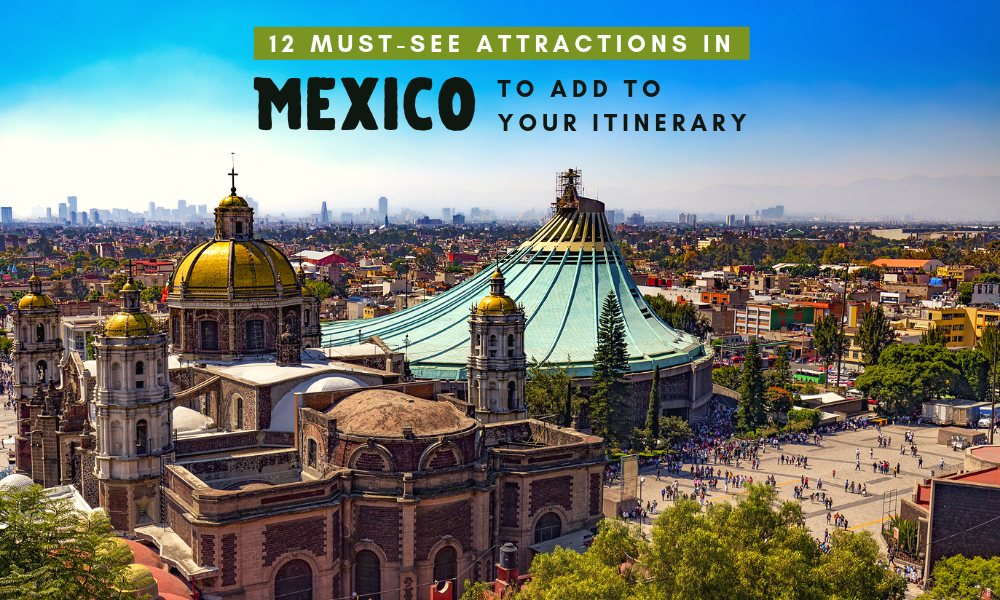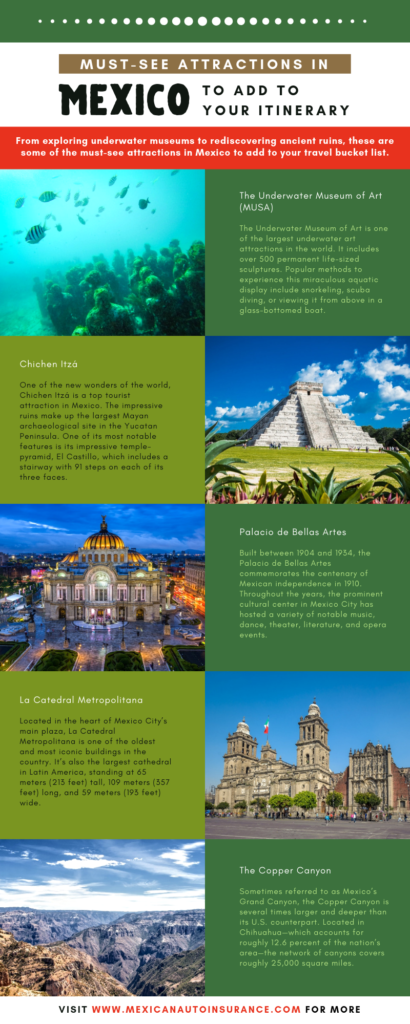
Mexico is a diverse country filled with innumerable sights and activities to suit the travel style of any globetrotter. Besides luxurious beaches, the country offers a wide variety of cultural, culinary, and exhilarating experiences. From exploring underwater museums to rediscovering ancient ruins, these are some of the must-see attractions in Mexico to add to your travel bucket list.
The Underwater Museum of Art (MUSA)
The Underwater Museum of Art is one of the largest underwater art attractions in the world. It includes over 500 permanent life-sized sculptures. Further, it boasts a unique and imaginative design—the structure’s material facilitates the growth of coral reefs, demonstrating the relationship between art and nature. Popular methods to experience this miraculous aquatic display include snorkeling, scuba diving, or viewing it from above in a glass-bottomed boat.
Chichen Itzá
One of the new wonders of the world, Chichen Itzá is a top tourist attraction in Mexico. The impressive ruins make up the largest Mayan archaeological site in the Yucatan Peninsula. One of its most notable features is its impressive temple-pyramid, El Castillo, which includes a stairway with 91 steps on each of its three faces. Additional attractions at the complex include structures such as the Great Ballcourt, the Temple of the Warriors, and El Caracol—a circular observatory.
Palacio de Bellas Artes
Built between 1904 and 1934, the Palacio de Bellas Artes commemorates the centenary of Mexican independence in 1910. Throughout the years, the prominent cultural center in Mexico City has hosted a variety of notable music, dance, theater, literature, and opera events. The center also includes murals by famed artists such as Diego Rivera, José Clemente Orozco, Rufino Tamayo, and David Siqueiros.
La Catedral Metropolitana
Located in the heart of Mexico City’s main plaza, La Catedral Metropolitana is one of the oldest and most iconic buildings in the country. It’s also the largest cathedral in Latin America, standing at 65 meters (213 feet) tall, 109 meters (357 feet) long, and 59 meters (193 feet) wide. Due to its 250-year construction period, the cathedral features a unique variety of architectural styles including Renaissance, Baroque, and Neoclassical.
The Copper Canyon
Sometimes referred to as Mexico’s Grand Canyon, the Copper Canyon is several times larger and deeper than its U.S. counterpart. Located in Chihuahua—which accounts for roughly 12.6 percent of the nation’s area—the network of canyons covers roughly 25,000 square miles. One of the most popular ways to experience this incredible natural attraction is by taking a ride on the famous Ferrocarril Chihuahua al Pacífico train. The railway takes passengers over 37 bridges, through 86 tunnels, and reaches altitudes of 2,400 meters (7,900 feet) above sea level.
Templo Mayor
Also known as the Great Temple, Templo Mayor served as a focal point of the Aztec religion. The architects dedicated its twin temples to the rain god, Tlaloc, and the war god, Huitzilopochtli. During its prime, the temple served as the location of many human sacrifices, coronations, and other state occasions for years to come. After its initial construction in 1440 CE, the structure underwent several renovations, improvements, and enlargements until 1502 CE when it reached its final height of 60 meters (180 feet).
Cenote Dos Ojos
Located just outside of Tulum, Cenote Dos Ojos is one of Mexico’s largest underwater cave systems. Its name, which translates to “the cavern of two eyes,” refers to the two sinkholes located in the cenote. Since the pools’ water filters through limestone, they offer a crystal-clear snorkeling and scuba diving experience.
Xcaret
Xcaret is an eco-archaeological theme park located in the Riviera Maya. It includes over 50 natural and cultural attractions such as underground rivers, a coral reef aquarium, a butterfly garden, breathtaking chapels, archeological sites, entertaining performances, and a recreation of a Mayan village.
Basilica of Our Lady of Guadalupe
One of the most popular religious sites in the world, over 12 million people visit the Basilica of Our Lady of Guadalupe each year. As such, it’s considered the second-most-important Catholic shrine after Vatican City. The impressive Roman Catholic church resides on the site where Mexico’s patron saint, the Virgin of Guadalupe, appeared to Juan Diego. Many believe that the saint revealed herself to the poor boy in a vision. To provide proof, the Virgin Guadalupe arranged flowers in his cloak and instructed him to open it when he returned to the bishop. When he did, a miraculous image of Our Lady of Guadalupe appeared on the cloak’s surface. The cloak is now kept behind bullet-proof glass in the immense circular building for all to see.
Uxmal
Many individuals consider Uxmal to be one of the most important Mayan archaeological sites in the world. Spanning roughly 150 acres, the ancient city is perhaps best known for its tallest structure, the Pyramid of the Magician. Translating to “thrice-built,” the city’s name refers to the fact that construction of the 115-foot tall Mesoamerican step pyramid took place on top of pre-existing pyramids.
The Pípila Monument
Located on a hill high above the city of Guanajuato, Pípila Monument commemorates the hero who lead the Hidalgo forces to their first independence movement victory. While the Pípila Monument alone is a stunning sight, part of what makes the structure a must-visit destination in Mexico is its panoramic view of Guanajuato. From its location on a hill, the monument overlooks this vibrant city known for its baroque colonial architecture and rainbow-colored houses.
Museo Nacional de Antropologia
The Museo Nacional de Antropologia is the largest and most-visited museum in Mexico. Since its creation over half a century ago, the museum has collected a remarkable variety of archaeological and anthropological relics from Mexico’s indigenous heritage. Today, it contains the most impressive collection of Mesoamerican artifacts in the world, including the Stone of the Sun or “Aztec Calendar” and the Aztec Xochipilli statue.
To stay safe while exploring these incredible must-see attractions in Mexico, it’s important to invest in proper travel insurance. Since most foreign insurance plans are not permissible south of the border, forgetting to apply for coverage could leave you vulnerable in case of an accident abroad.Fortunately, Lewis and Lewis Insurance Agency offers a variety of different auto, home, medical, and boat insurance plans to suit your specific needs. For optimal convenience, you can get your quick and free Mexican car insurance quote online today.



